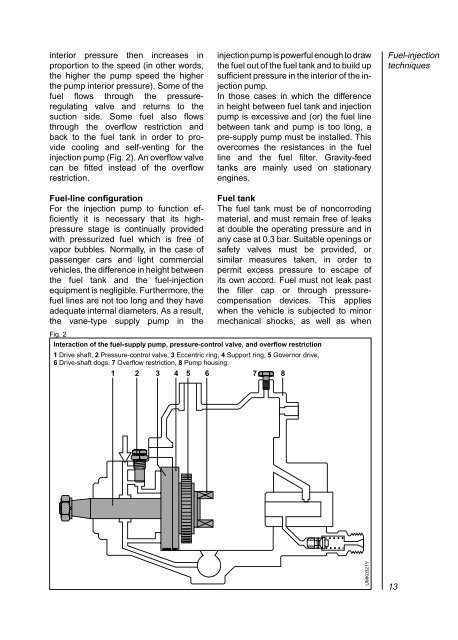Diesel Distributor Fuel-Injection Pumps VE - Gnarlodious
Diesel Distributor Fuel-Injection Pumps VE - Gnarlodious
Diesel Distributor Fuel-Injection Pumps VE - Gnarlodious
- No tags were found...
You also want an ePaper? Increase the reach of your titles
YUMPU automatically turns print PDFs into web optimized ePapers that Google loves.
interior pressure then increases inproportion to the speed (in other words,the higher the pump speed the higherthe pump interior pressure). Some of thefuel flows through the pressureregulatingvalve and returns to thesuction side. Some fuel also flowsthrough the overflow restriction andback to the fuel tank in order to providecooling and self-venting for theinjection pump (Fig. 2). An overflow valvecan be fitted instead of the overflowrestriction.<strong>Fuel</strong>-line configurationFor the injection pump to function efficientlyit is necessary that its highpressurestage is continually providedwith pressurized fuel which is free ofvapor bubbles. Normally, in the case ofpassenger cars and light commercialvehicles, the difference in height betweenthe fuel tank and the fuel-injectionequipment is negligible. Furthermore, thefuel lines are not too long and they haveadequate internal diameters. As a result,the vane-type supply pump in theinjection pump is powerful enough to drawthe fuel out of the fuel tank and to build upsufficient pressure in the interior of the injectionpump.In those cases in which the differencein height between fuel tank and injectionpump is excessive and (or) the fuel linebetween tank and pump is too long, apre-supply pump must be installed. Thisovercomes the resistances in the fuelline and the fuel filter. Gravity-feedtanks are mainly used on stationaryengines.<strong>Fuel</strong> tankThe fuel tank must be of noncorrodingmaterial, and must remain free of leaksat double the operating pressure and inany case at 0.3 bar. Suitable openings orsafety valves must be provided, orsimilar measures taken, in order topermit excess pressure to escape ofits own accord. <strong>Fuel</strong> must not leak pastthe filler cap or through pressurecompensationdevices. This applieswhen the vehicle is subjected to minormechanical shocks, as well as when<strong>Fuel</strong>-injectiontechniquesFig. 2Interaction of the fuel-supply pump, pressure-control valve, and overflow restriction1 Drive shaft, 2 Pressure-control valve, 3 Eccentric ring, 4 Support ring, 5 Governor drive,6 Drive-shaft dogs, 7 Overflow restriction, 8 Pump housing.1 2 3 4 5 6 7 8UMK0321Y13



